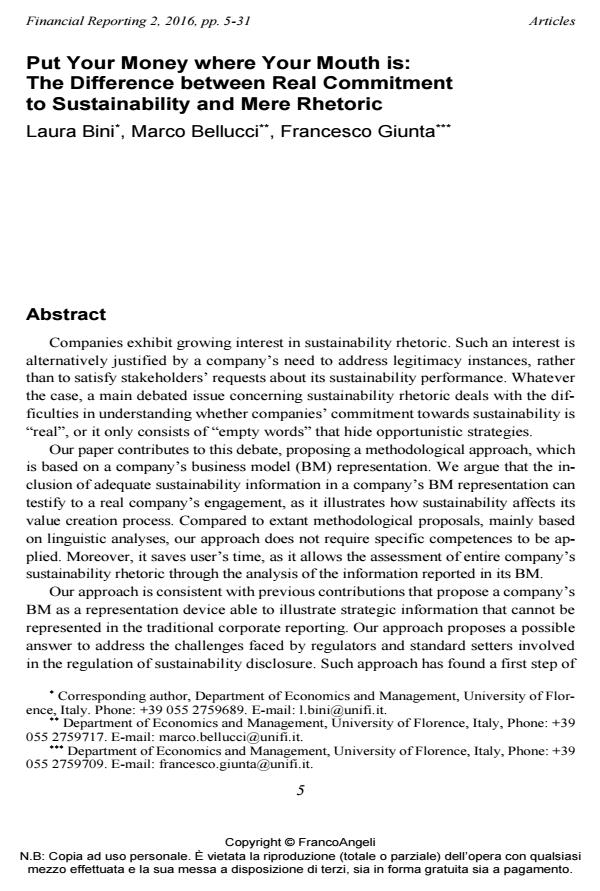Put Your Money where Your Mouth is: The Difference between Real Commitment to Sustainability and Mere Rhetoric
Journal title FINANCIAL REPORTING
Author/s Laura Bini, Marco Bellucci, Francesco Giunta
Publishing Year 2017 Issue 2016/2
Language English Pages 27 P. 5-31 File size 278 KB
DOI 10.3280/FR2016-002001
DOI is like a bar code for intellectual property: to have more infomation
click here
Below, you can see the article first page
If you want to buy this article in PDF format, you can do it, following the instructions to buy download credits

FrancoAngeli is member of Publishers International Linking Association, Inc (PILA), a not-for-profit association which run the CrossRef service enabling links to and from online scholarly content.
Companies exhibit growing interest in sustainability rhetoric. Such an interest is alternatively justified by a company’s need to address legitimacy instances, rather than to satisfy stakeholders’ requests about its sustainability performance. Whatever the case, a main debated issue concerning sustainability rhetoric deals with the difficulties in understanding whether companies’ commitment towards sustainability is "real", or it only consists of "empty words" that hide opportunistic strategies. Our paper contributes to this debate, proposing a methodological approach, which is based on a company’s business model (BM) representation. We argue that the inclusion of adequate sustainability information in a company’s BM representation can testify to a real company’s engagement, as it illustrates how sustainability affects its value creation process. Compared to extant methodological proposals, mainly based on linguistic analyses, our approach does not require specific competences to be applied. Moreover, it saves user’s time, as it allows the assessment of entire company’s sustainability rhetoric through the analysis of the information reported in its BM. Our approach is consistent with previous contributions that propose a company’s BM as a representation device able to illustrate strategic information that cannot be represented in the traditional corporate reporting. Our approach proposes a possible answer to address the challenges faced by regulators and standard setters involved in the regulation of sustainability disclosure. Such approach has found a first step of implementation in the UK, where since 2013, listed companies are requested to describe their BM in Strategic Reports.
Keywords: Sustainability rhetoric, business model, corporate social responsibility, non-financial disclosure, mining industry.
- Corporate governance: Search for the advanced practices Francesco De Luca, Ho-Tan-Phat Phan, pp.177 (DOI:10.22495/cpr19p9)
- How Cheap Talk in Climate Disclosures relates to Climate Initiatives, Corporate Emissions, and Reputation Risk Julia Bingler, Mathias Kraus, Markus Leippold, Nicolas Webersinke, in SSRN Electronic Journal /2022
DOI: 10.2139/ssrn.4000708 - Cheap Talk in Corporate Climate Commitments: The Role of Active Institutional Ownership, Signaling, Materiality, and Sentiment Julia Anna Bingler, Mathias Kraus, Markus Leippold, Nicolas Webersinke, in SSRN Electronic Journal /2022
DOI: 10.2139/ssrn.3998435 - Beyond financial reporting disclosures Bruce K. Behn, Francesca Rossignoli, Silvano Corbella, in FINANCIAL REPORTING 2/2019 pp.5
DOI: 10.3280/FR2019-002001 - Informativeness Assessment of Risk and Risk-Management Disclosure in Corporate Reporting: An Empirical Analysis of Italian Large Listed Firms Francesco De Luca, Ho-Tan-Phat Phan, in FINANCIAL REPORTING 2/2019 pp.9
DOI: 10.3280/FR2019-002002 - Integrated Sustainability Reporting Laura Bini, Marco Bellucci, pp.9 (ISBN:978-3-030-24953-3)
Laura Bini, Marco Bellucci, Francesco Giunta, Put Your Money where Your Mouth is: The Difference between Real Commitment to Sustainability and Mere Rhetoric in "FINANCIAL REPORTING" 2/2016, pp 5-31, DOI: 10.3280/FR2016-002001